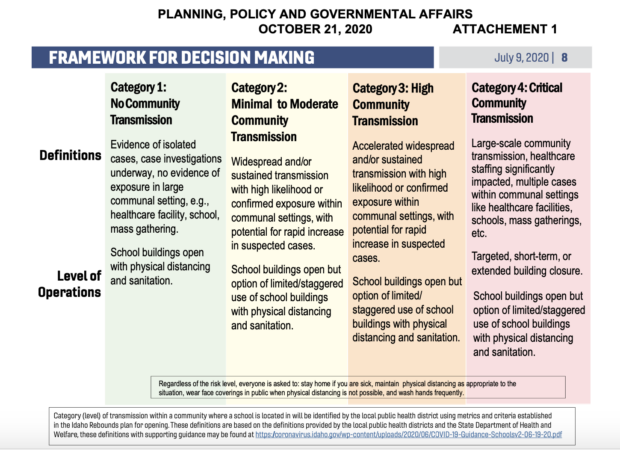The State Board of Education amended Idaho’s school reopening plan Wednesday, moving from three risk categories to four and doing away with a recommendation that schools move to full remote learning under the highest risk category.
Board members voted unanimously to approve the changes during a virtual meeting that lasted nearly nine hours.
Board President Debbie Critchfield said state officials have learned more information about the virus since the original reopening plan was published July 9. Critchfield said a specific reason for doing away with the full remote learning recommendation in the red is because infection and transmission rates are lower in schools than in communities at large.
“We are expanding that to allow districts to have more room to maneuver,” Critchfield said. “What we’re learning is you don’t have to be fully remote in red.”
The new categories are:
- Category 1 green: No community transmission, schools buildings are open.
- Category 2 yellow: Minimal to moderate community transmission, school buildings are open with the option of limited or staggered use of the buildings.
- Category 3 orange: High community transmission, schools buildings are open with the option of limited or staggered use.
- Category 4 red: Critical community transmission, districts could use targeted short-term or extended closures, or keep school buildings open with the option of limited or staggered use.
 Several board members emphasized the changes to the reopening plan are designed to give local schools more flexibility. The hallmark of the state’s reopening plan is empowering local school boards and charter leaders to develop their own learning plans, as opposed to issuing state mandates and rules.
Several board members emphasized the changes to the reopening plan are designed to give local schools more flexibility. The hallmark of the state’s reopening plan is empowering local school boards and charter leaders to develop their own learning plans, as opposed to issuing state mandates and rules.
“The reality is we cannot orchestrate this from the state level, it has got to be a local decision,” State Board member Linda Clark said.
Central District Health’s moved Ada County schools to the red last week, but still supported some level of in-person learning in schools. That decision was a factor in the state board’s discussion.
“This plan, again, is reflecting what some public health districts are allowing schools to do even though their community transmission and risk level has moved to red,” said Greg Wilson, the education liaison to Governor Brad Little.
Just as before, the guidance is only a recommendation and not a mandate.
“Nothing in the categories are required mandates, they are suggestions on what mitigation strategies will help reduce infection rates,” Critchfield said.
The changes are the latest development in an evolving set of state guidelines.
The State Board and Little both endorsed the original reopening plan in July.
Some public health districts, including Eastern Idaho Public Health and Southwest District Health, soon started using four risk categories for COVID-19 spread. Central District Health was still using three categories, as of this week.
One thing that hasn’t changed is the state’s preference for keeping schools open.
“We want students to be in-person,” Critchfield said.
Senior project waived this year
In other action Wednesday, the State Board also voted unanimously to waive the senior project as a graduation requirement for the current 2020-21 school year.
Schools will have the option to keep the senior project in place if they prefer.
“I have no doubt those who feel it is valuable can, and will, require it if it is a local option,” Clark said.
Board members said making the move now, in the fall, was preferable to waiting until the end of the school year to make a decision. The move also offers flexibility, they said. If districts’ like the project they can retain the requirement locally. If they feel there are too many interruptions this year, they can skip it without needing any additional approval from the state.
